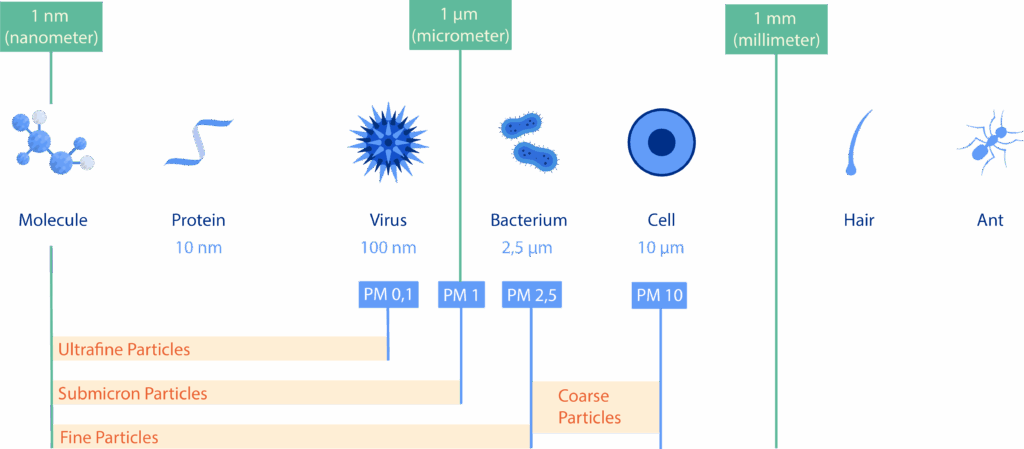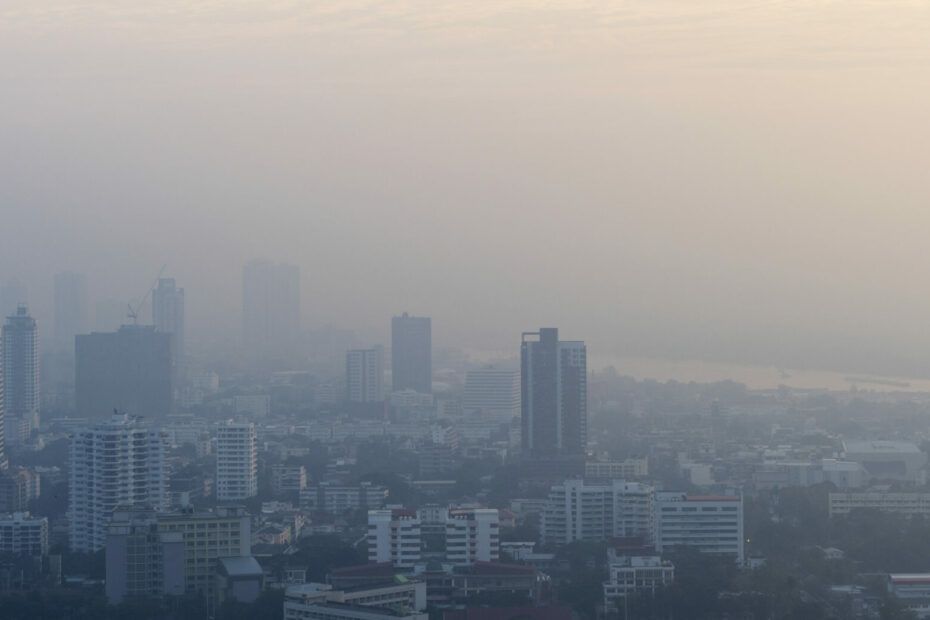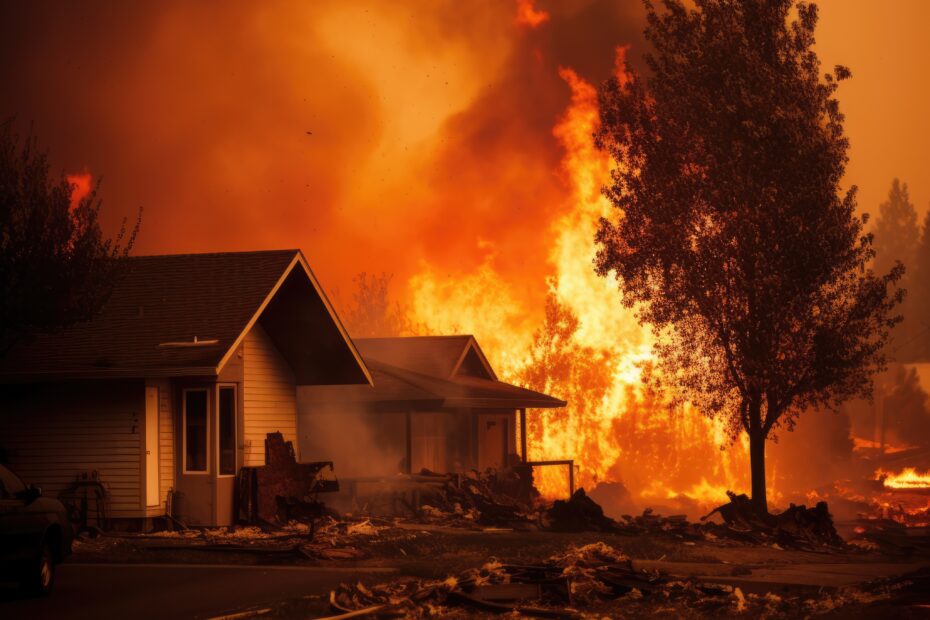What are fine particles?
Fine particles, commonly known by their English abbreviation “PM” (Particulate Matter), refer to a group of airborne particles suspended in the air collectively called aerosols.
These particles are classified according to their diameter:
- PM2.5: particles smaller than 2.5 micrometers,
- PM0.1, or ultrafine particles, with a diameter below 100 nanometers.
Unlike larger dust particles, fine particles are too light to fall to the ground by gravity alone.
This is what makes them particularly harmful, they remain suspended in the air and can be easily inhaled.

PM 1 : The smallest and most harmful particles. They can reach the deepest parts of the lungs, pass through the alveolar membranes, enter the bloodstream, damage artery walls, and spread to the cardiovascular system and organs.
They include dust, combustion residues, and viruses.
PM2,5 : Roughly the size of a red blood cell, these particles can also reach the alveoli, where they contribute to pulmonary and cardiovascular diseases by clogging small blood vessels.
They include pollen, spores, and other organic matter.
PM10 : Larger particles, comparable in size to a cell or bacterium. PM10 tend to settle in the upper respiratory tract but are less harmful than PM2.5.
Examples include coarse dust, sand, leaves, hair, and other visible airborne materials.
Summary
| Category | Definition | Diameter |
|---|---|---|
| PM10 | Inhalable particles | < 10 µm |
| PM2.5 | Fine particles | < 2.5 µm |
| PM1 | Very fine particles | < 1 µm |
| PM0.1 | Ultrafine particles | < 0.1 µm |
Where do fine particles come from?
Fine particles can originate from natural sources or human activities, but most of them are generated by us.
- Road traffic, wood, oil, and gas heating release PM2.5 and PM10 through combustion and material friction (brakes, tires).
- Construction sites and quarries produce larger particles (PM10) due to the nature of their materials and operations.
- Manufacturing industries emit both PM10 and PM2.5 through various combustion and production processes.
- Diesel engines are another major source, which is why modern diesel vehicles are now equipped with particle filters to reduce emissions.

Winter pollution peaks
Cold weather often worsens pollution levels. During winter, temperature inversions can trap cold air (and pollutants) near the ground under a layer of warmer air. This prevents dispersion and causes a sharp decline in air quality.
Meanwhile, heating systems, traffic, and industrial activities continue to release emissions, further aggravating pollution.
To mitigate this, local authorities may implement speed reductions on highways or ban open-air burning of green waste during high pollution periods.
Underground Pollution : A Hidden Threat
Subway tunnels and underground stations are hotspots for fine particle pollution. They often contain iron microparticles, known to aggravate inflammation and pose health risks.
In Paris, PM10 concentrations in some metro stations far exceed air quality standards.
In response, several initiatives aim to improve air monitoring and reduce worker exposure in these confined environments.
Why are fine particles so dangerous?
Fine particles act like tiny sponges for pollution.
They absorb other toxic substances such as pesticides and heavy metals, which makes them even more harmful.
Once inhaled, they don’t just stay in the lungs, they can enter the bloodstream and spread throughout the body, increasing the risks of inflammation, heart disease, and cancer.
Research led by institutions like the International Agency for Research on Cancer (IARC) and Santé Publique France confirms the severe health impacts of particulate matter. Classified as carcinogenic, PM exposure is linked to lung and colon cancers, as well as many other chronic diseases.
In France alone, fine particles are responsible for thousands of premature deaths every year and contribute to asthma, COPD, strokes, and heart attacks.
Main Health Impacts
Respiratory system :
- Irritation of the nose, throat, and lungs
- Increased asthma attacks and bronchitis episodes
- Aggravation of chronic respiratory diseases like COPD
Cardiovascular system :
- Heart disease caused by inflammation and oxidative stress
- Higher risk of stroke due to impaired blood flow and blood pressure
In short, fine particles mainly affect the respiratory and cardiovascular systems, but their impact can extend much further.

Monitoring and regulations
- In France, monitoring is handled by AASQA (Approved Air Quality Monitoring Associations), which publish the ATMO index including PM2.5 and PM10 concentrations.
- At the European level, the European Environment Agency (EEA) manages the EIONET network, harmonizing environmental and air quality data.
- The World Health Organization (WHO) updated its air quality guidelines in 2021, setting annual limits at 15 µg/m³ for PM10 and 5 µg/m³ for PM2.5, reflecting evidence that even low exposure levels can harm health.
In 2022, the European Commission proposed stricter air quality goals for 2030, aligned with its ambition to achieve near-zero pollution by 2050.
Beyond the Lungs and Heart
Recent studies show that fine particles can affect other organs and systems too. By entering the bloodstream, they may contribute to type 2 diabetes and neurodegenerative diseases.
Children are particularly vulnerable, and long-term exposure has been linked to reduced life expectancy (Pope, 2004; Amadou, 2020).
Key Findings from These Studies
Two main conclusions have emerged regarding the health impact of airborne particulate matter:
- No safe threshold has been identified below which there would be no health effects (Dominici, 2019).
- Long-term exposure to even low levels of particulate matter leads to significant health impacts (Santé Publique France, 2022).
These findings highlight the importance of prioritizing chronic exposure, not just short-term pollution peaks when developing public health policies aimed at reducing the health burden of fine particles.

What Does Quad-Lab Offer?
At Quad-Lab, we provide tailored fine particle analysis for every need—whether it’s assessing indoor air quality or meeting regulatory requirements.
We guide our clients in selecting the most relevant sampling methods, and we also rent out sampling equipment to ensure optimal sample collection and reliable results.



